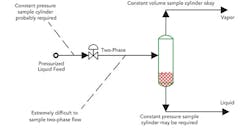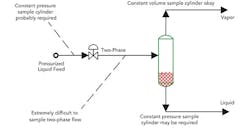Fluid Handling: Ensure Satisfactory Sampling
[pullquote]
When accurate, online analyzers often give the best information on process compositions. However, such analyzers generally are expensive and delicate as well as time consuming and costly to maintain. So, plants tend to install a minimum number of them. Instead, most facilities send samples to a laboratory for monitoring and troubleshooting. Permanent sample installations with flow-through loops provide the most consistent method for gathering samples (see: “Get Valid Samples”). Flow-through loops also may be costly, though, and pose their own problems.
Troubleshooting frequently requires taking samples from rarely used locations. Samples from pressurized systems typically go into cylinders, often called sample bombs. These sample cylinders come in two main types: constant volume and constant pressure.
Most engineers are familiar with constant volume cylinders. They are fixed in place with valves at both ends. The downstream side of the cylinder may be vented to atmosphere (if safe) or coupled to a closed disposal/vent system. In use, the inlet and outlet valves are opened, and flow continues into the cylinder until adequate purging has taken place. Then, the outlet valve is closed, followed by the inlet valve. The sample now is in the constant volume cylinder.
When using constant volume sampling, a significant pressure drop can occur across the inlet valve. Consider the situation with a separator drum (Figure 1). Attempting to take a constant volume sample of the drum feed, if it’s a pressurized liquid, may result in flashing across the cylinder inlet valve and, thus, two-phase flow going through the cylinder. In such a case, possible liquid/gas phase separation likely will render the sample unrepresentative. In addition, the laboratory will find the sample very difficult to handle.
Figure 1. Flashing due to pressure drop across the inlet valve may lead to an unrepresentative sample.
One solution is to take samples of the streams downstream of the drum and then use separate analyses of the gas and liquid samples along with their flowrates to calculate the feed composition.
The gas sample is relatively straightforward. However, the downstream liquid still may flash — you may not have prevented the problem, just moved where it arises.
If you’re dealing with a hot system, using a sample cooler on the liquid may drop the temperature enough to prevent flashing. This enables a constant volume cylinder to sample correctly.
Temperature drops during sampling can create their own problems for both gas and flashing liquid sampling. In some systems, the pressure drop across the inlet valve can lower temperature significantly. With sufficient moisture present, the cylinder valves may freeze open.
One solution to these sampling difficulties is to use a constant pressure cylinder. This type of cylinder has an internal piston. A fluid acting on one side of the piston raises the pressure to that of the sampling system. The cylinder is attached to the process and the valves are opened; then the pressurizing fluid is gradually released until the cylinder is full. This type of approach would work for sampling the upstream liquid as well as the downstream liquid. The pressurizing fluid often is nitrogen or another gas inert to the process that doesn’t affect the analysis if it leaks into the sample.
Pressurized cylinders must include a rupture disc. If the sample is full of liquid, even a small temperature increase can cause extremely high pressures due to density changes. Pressurized cylinder samples should include a vapor cushion to cope with these pressure changes. However, such a cushion doesn’t negate the need for the rupture disk, or for careful sample handling on the way to the laboratory. Additionally, because the cylinder typically is at high pressure at all times, the rupture disc protects against other sources of over-pressure.
One disadvantage of the pressurized cylinder is that it normally isn’t subjected to a purge step with free flow through the cylinder. So, any impurities present in the cylinder remain. These can come from more than just the cylinder itself. If normal operation through the sample point is low or no flow, surface contaminants and solids may build up. Taking a sample can push these into the cylinder.
If you must make low concentration (ppm or less) tests, take at least two samples, one after the other, with pressurized cylinders. Fill these sample cylinders slowly. Low entrance velocities will help avoid pushing surface contaminants into the samples. If the first sample gives a higher concentration of interest than the second, surface contamination probably is the culprit. In such a case, continue sampling until only small changes occur in the concentration between consecutive samples.
(For pointers on sampling systems for online analyzers, see “Choose the Right Sampling System Transport Line,” “Consider Flow Regime’s Impact on Sample Analysis,” and “Check Sample System Pressure Drop.”)
ANDREW SLOLEY is a Chemical Processing contributing editor. You can email him at [email protected].


